Alaska Fish & Wildlife News
December 2015
Harvesting Seaweed in Alaska
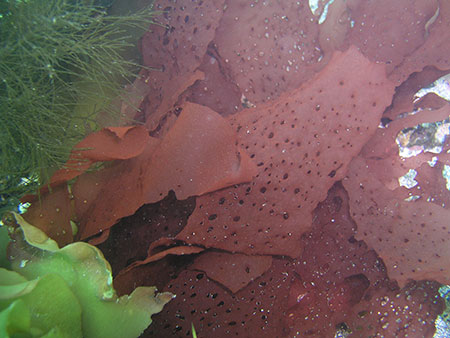
Fall has come full swing, the leaves have changed color and blown off the trees. The talk around the office is football and hunting. Snow has even made an appearance. It’s time to bid autumn goodbye and get ready for winter. For many people this means harvesting the last of your crops and prepping your garden beds for next year. Some people cover their beds with seaweed to add nutrients and protect bulbs from harsh freezing. Have you ever thought, “Do I need a permit for this?”
The short answer is no, but it depends on where you harvest it. And it might need to be dead. That may seem odd, but Fish and Game manages aquatic plants as well as fish and wildlife. That’s no surprise to folks in the roe-on-kelp fishery, but what about a gardener collecting mulch or a cook making a seaweed salad or kelp pickles?
The use of aquatic plants, which includes algae and seaweed, is growing worldwide. For this article, I will be speaking about only marine species and use the terms seaweed, algae, and aquatic plants interchangeably.
There is a range of uses for a wide variety of aquatic plants. There are commercial endeavors looking to make natural supplements, fertilizer, and products for consumption in local and Asian markets. Some algae species are consumed by subsistence users and have cultural importance, while other people merely want it to cover their gardens. Research is being conducted on life cycles, natural progression, isotopes and even radiation absorption.
As more and more people want to use the resource, the bigger question becomes: How does Fish and Game manage the resource with its user groups? How much is known about seaweeds, their reproductive cycle, their genetic variability, and their biomass and rebound rates? Are their populations sustainable? Can they handle commercial collection? The most common answer is, “It depends.” With all these different uses come different regulations which vary around the state. When collecting algae for subsistence or personal use, the first question is: where do you live?
Why it matters where you live
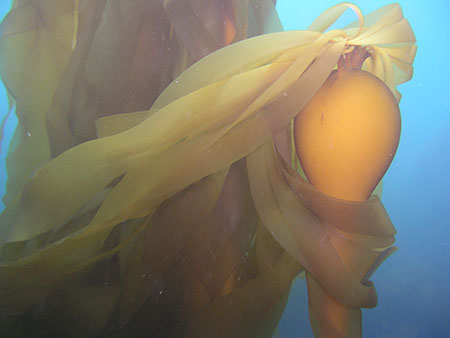
Along most of Alaska’s coastline it’s okay to harvest kelp for personal, noncommercial use. The vast majority of Alaska’s coastline is considered to be a “subsistence use area.” If you are within a subsistence area, then you are allowed to harvest seaweed without a sport fishing license for noncommercial purposes; there are no seasonal closures, and there are no daily harvest limits (5 AAC 37.100 (b)). However, always check with your regional office to make sure there are not any emergency closures in your area.
Where harvest is allowed, these are the guidelines:
5 AAC 37.300. Harvesting requirements for macrocystis kelp
(a) Macrocystis kelp shall be harvested in a manner that prevents dislodging of the entire plant from the bottom, and prevents straining or breaking the plant.
(b) Macrocystis kelp may not be cut at a depth greater than one foot below the surface of the water, and only the upper portion of the plant may be retained.
(c) The use of diving gear to harvest macrocystis kelp is prohibited.
(d) The department shall close to the harvest of macrocystis kelp areas in which herring are spawning.
The coast areas easily accessible to most of Alaska’s population are designated as “nonsubsistence areas.” These five areas are near Anchorage, Valdez, Fairbanks, Juneau, and Ketchikan. For our purposes, only the coastal areas are relevant. A map of these areas can be found on the ADF&G website. The Seward area is also closed.
Very specific definitions are available referencing 5 AAC 99.015.
These boundaries designate whether or not subsistence regulations apply. After going through the personal use regulations, speaking with Department of Law, and Fish and Game staff, to make a long story short, the harvest of live aquatic plants in nonsubsistence areas are currently prohibited.
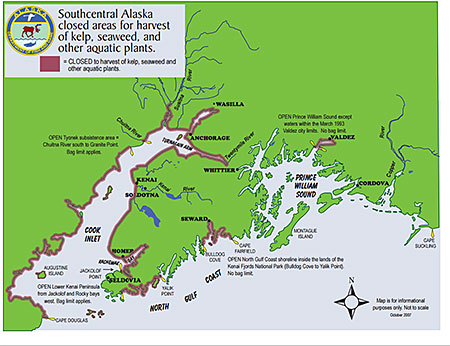
Cook Inlet is closed to taking aquatic plants, however, there are two subsistence areas within that are open. These have a 10 pound wet weight daily bag limit (5 AAC 37.320): The Tyonek subsistence area in western Cook Inlet between Chuitna River south to Granite Point; and the Lower Kenai Peninsula between Jackolof Point and Rocky Bays. A map is available at http://www.adfg.alaska.gov/static-sf/region2/pdfpubs/kelp.pdf.
Dead seaweed on the beach
What about collecting seaweed that’s washed up on the beach in the Southeast nonsubsistence areas, around Juneau and Ketchikan? The interpretation of regulation comes down to whether or not it is dead. ADF&G’s “Harvesting Kelp in Southcentral Alaska” brochure says, “In an area closed to the taking of kelp and other aquatic plants, a person may not harvest kelp that is alive and growing, no matter if the live kelp or seaweed is attached, free floating or washed up on the beach.”
Alaska Wildlife Troopers enforce regulations. Sgt. Aaron Frenzel in Juneau said, “We don’t care if people collect seaweed off the beach for their gardens.” As long as it is dead and there is no commercial activity involved. He recalled a situation where someone (without any appropriate permits) was harvesting aquatic plants in a subsistence area and selling it to a grocery store, and that was stopped.
Several troopers mentioned a situation in Seward around 2006 where a large amount of live kelp was torn off a beach at low tide and sold commercially. The troopers were contacted by concerned members of the public and by Fish and Game biologists and they took action. Lt. McConnell in Soldotna said a consideration for enforcement is the basic question, “Is there a problem?” If people call, or biologists are concerned, the troopers will check it out.
Other permits and other uses
As the Permit Coordinator, I process Fish Resource Permits (FRPs) for marine collections for research or educational purposes (AS 16.05.340 (b) and AS 16.05.930). This means I get to see what students and researchers are looking in to. This can be very interesting and I feel gives me a little heads up on what is the cutting edge of research. Just as a few examples, I have seen permits processed for ongoing collections in Kachemak Bay, which is otherwise closed to collections, to catalog the change of species and abundance in the estuary with response to climate change and human-induced disturbances. This long-running data set helps provide the ground work for system wide trends that can be applied to coastal management. In the recent years there also have been permits for collecting rockweed and kelp to test for radiation exposure from the Fukushima nuclear disaster since it is known that these species absorb the radioactive isotopes first. (None has been found yet.)
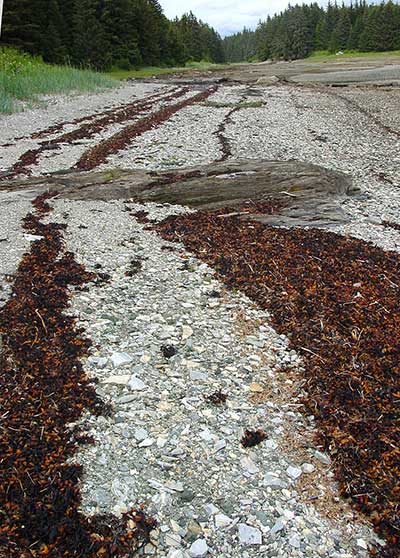
Another aspect of research that is an area of interest is the propagation of algae. The life cycle of algae can behave like a plant and like an animal in so many ways. It is not a simple flow chart, and to make matters even more difficult, each species can vary so much! I will not get into the details, but you could definitely spend a lifetime learning these lifecycles and how to grow algae, and there are people who do. Cultivation of algae is done in other areas in the world for food and other products and that knowledge is now being applied to native plants in Alaska. The general knowledge is known, but the species and environment are new so the process still involves trial and error. Mature plants are collected and brought back to the lab to spawn in a sterile environment. Without getting into the details, once spores are created, they are seeded onto lines, which then can be placed back into marine waters to grow into adult plants for harvest. Right now this is still in the research and development phase, but there is hope it will become commercially feasible for aquatic shellfish farms to raise algae as an additional product.
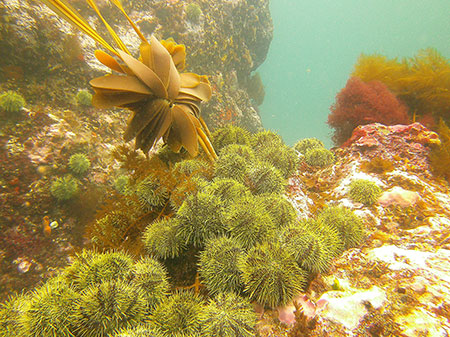
The final type of collection of seaweed I will address today is for commercial purposes. Aquatic farms can add harvest of naturally set algae on their gear to their aquatic farm permits for sale (5 AAC 41.285). And as of right now, there are no aquatic farm hatcheries or nurseries that are permitted to create their own seed source for grow-out as a commercial product (like bivalves). As mentioned earlier, this is still in research in development.
Harvest of wild seaweed outside of an aquatic farm for commercial sale is authorized under a Commissioner’s Permit (5 AAC 37.100). This type of permit is issued by each regional office and is evaluated on a case by case basis. Commissioner’s Permits are the catch-all for species that are harvested by experimental gear for commercial purposes, or are not currently defined in regulation. Given that there has been no significant research done on the sustainability of harvesting large amounts of seaweed, staff are required to take the precautionary approach (5AAC 39.200). Staff must also consider subsistence needs outside of nonsubsistence areas before issuing a Commissioner’s Permit.
All in all, the variety of applications for what may seem to be an inconsequential piece of debris that gets hung up on your fishing gear are far reaching. The number of uses and applications rival the number of species in Alaska, some of which are defined by a single cell layer. Next time you think about collecting some seaweed for your gardens, stop and take a minute to think about your location and all the other uses for algae.
Common edible seaweeds in the Gulf of Alaska by Dolly Garza. Alaska Sea Grant College Program
NOTE: Update April 2022 - Personal Use for Southeast aquatic plant harvest with current regulations.
Michelle Morris is a biologist in Juneau.
Subscribe to be notified about new issues
Receive a monthly notice about new issues and articles.
